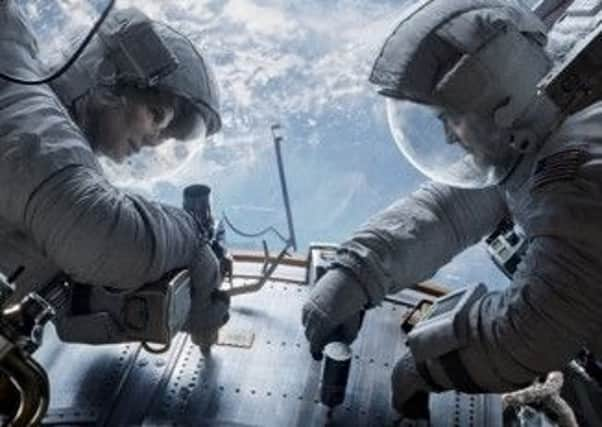‘The closest the earthbound can get to wandering heaven’


Gravity (12A)
Director: Alfonso Cuarón
Running time: 91 minutes
Star rating: * * * *
The opening shot sets the tone: a 13-minute continuous sequence which reveals Earth, then the stars, and a ship with three astronauts, floating freely, trying to stick an extra bit of hardware on the Hubble telescope.
“Wheeee,” exults one of the astronauts, which is the galactic equivalent of showing another Second World War pilot a picture of your wife and kids before heading out on a mission. That’s not much of a spoiler, since he’s part of the film’s first disaster. A hail of space debris trashes the ship, cuts off communications with Ground Control, and leaves just two survivors: veteran Matt Kowalski (George Clooney) and nervous medical engineer Ryan Stone (Bullock) who has never been in space before. She also has mere minutes of oxygen left in her suit and the debris is due to return in about 90 minutes.
Advertisement
Hide AdThe movie countdown is now running, and if Stone manages to overcome her breathing difficulties, new obstacles will pop up with the regularity of a whack-a-mole game.
As well as external challenges, Ryan has other problems. She is both space sick and heart sick, with a heavy melancholy that makes you wonder how she passed Nasa’s rigorous psych tests. Kowalski is heartier and more practical, but he’s not always around.
This is not a film to pop into your DVD. The scale is epic, and the 3D soundscape and landscape are so astounding and vivid that when viewed at an Imax cinema it feels like the closest the earthbound can get to wandering heaven. This kind of envelope-pushing effects showcase is often associated with the likes of James Cameron, but less often with the Mexican director Cuarón, who made the third, and prettiest, Harry Potter movie, and the plangent Children Of Men. Gravity is filled with touches that capture the agoraphobia of being in vast emptiness, looking out through a space helmet or a ship’s porthole, and the soundscape is equally unnerving – crackling radio transmissions, violent yet soundless crashes and a lot of panicky panting by Bullock.
Thank goodness for Bullock, because without her the emotional panorama would feel a lot more limited. She may not be the greatest of serious actresses, but she has a likeability that makes Ryan’s despair touching and tangible. If you see this film, try picturing how Nicole Kidman would have carried Ryan’s melodramatic back story, or survived lairy scenes where the camera rests on a lithe Bullock wearing just a flattering vest and underpants. Sure, there’s a subtext about rebirth in the way she glides through a narrow spaceship channel, but I couldn’t help but be reminded of one Nasa employee’s observation that in reality, astronaut underwear is actually a bit of umbilical tubing and a giant nappy.
Despite the arresting imagery, and a fusion of spirituality and science, Gravity is not a movie with big ideas about big ideas, and compared with the mysticism of Kubrick’s 2001, it is as weightless as any big budget popcorn film. Yet it does spark with ambition, and often it is a thrilling physical experience. Not a giant leap perhaps, but a small step forward.
Twitter: @SiobhanSynnot
FILM REVIEWS
How To Survive A Plague
Star rating: * * * *
David France’s award-winning documentary relies chiefly on archive and home movies to shape an impressionistic narrative of America at a time when hospitals would turn away Aids patients and funding was blocked by conservative politicians until those affected took it upon themselves to fight back. What makes this raw history of activism moving is France’s focus on individual men and women – including playwrights Jim Eigo and Larry Kramer, press executive Bob Rafsky and retired chemist Iris Long. Despite some repetition, this is a compelling social document.
On selected release from Friday.
Gloria (15)
Star rating: * * *
Advertisement
Hide AdAward-winning actress Paulina Garcia shines in this Chilean indie feature about a divorcee pushing 60 who is determined to restart her life by experimenting with the singles scenes. Like its heroine, Sebastian Lelio’s film is warm and surprisingly sprightly, and although it gets a little too pointed in the third act, Garcia and some great set pieces make this an unashamed crowd-pleaser.
On selected release.
Blue is the Warmest Colour (18)
Star rating: * * *
Tunisian-French director Abdellatif Kechiche’s Palme d’Or-winning film is a passionate romance between a needy Adele and gamine Emma, an artist with blue hair. Based on a graphic novel by Julie Maroh, there’s been controversy about the intense methods used by Kechiche while filming his actresses Adèle Exarchopoulos and Léa Seydoux, as well as the length and explicitness of the sex scenes. The dirty mac brigade may be disappointed to discover that their meals and philosophical chats are just as lengthily exploratory. Sometimes compelling but frankly, sometimes also a bit of a plod.
Glasgow Film Theatre, Wednesday, as part of Glasgay! On general release from 22 November.